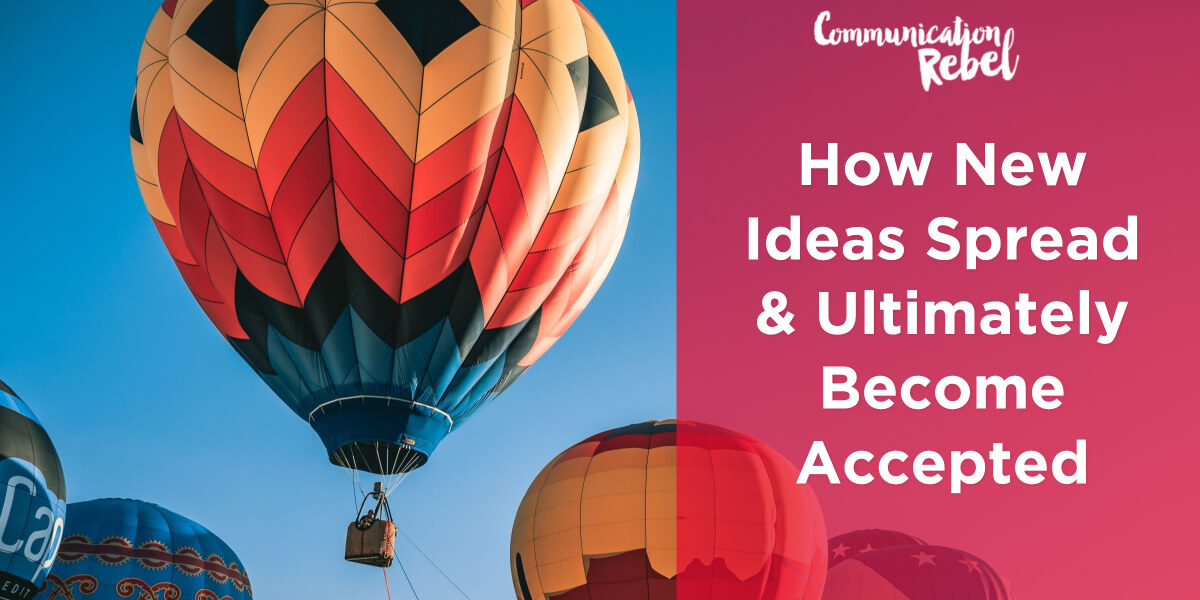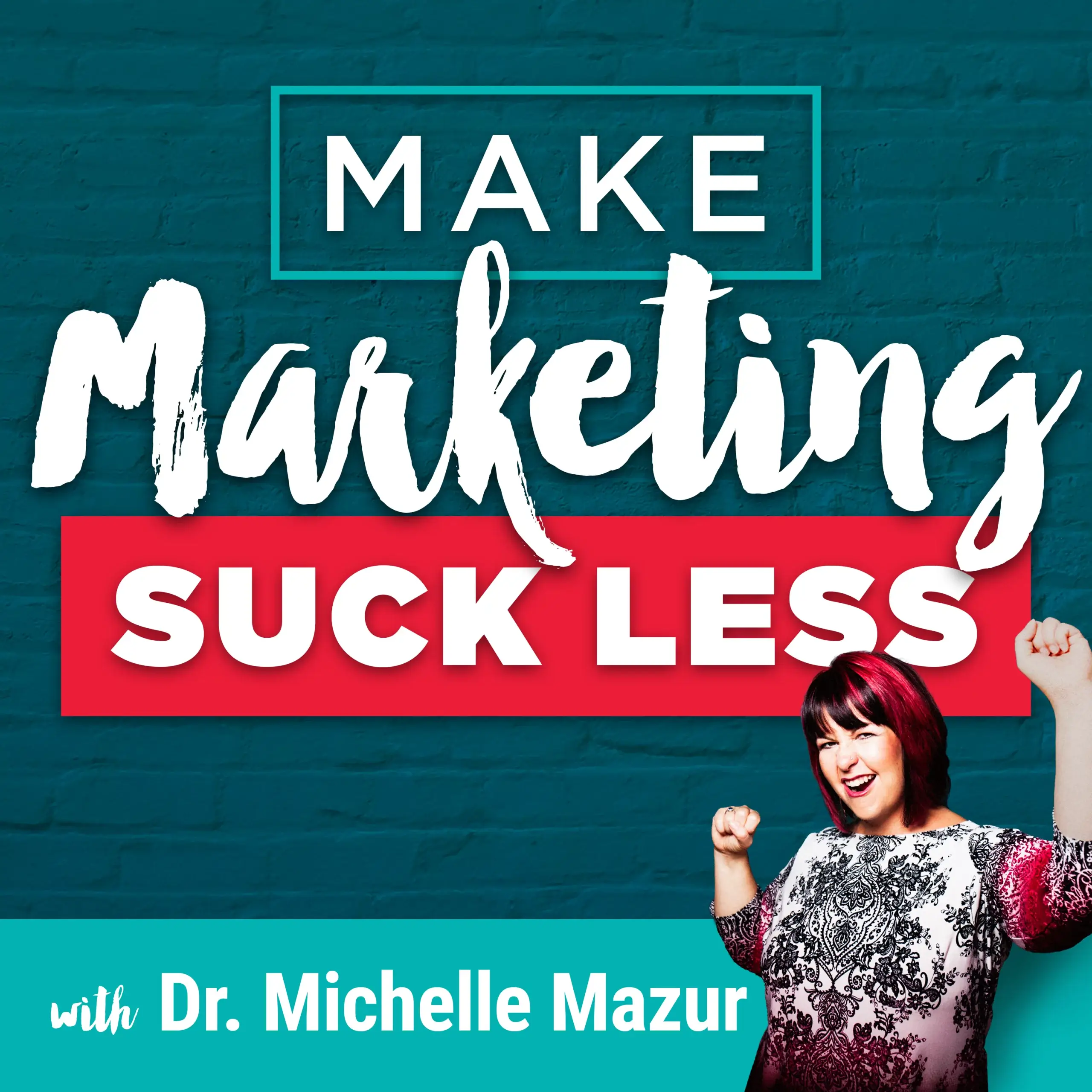Make Marketing Suck Less
How New Ideas Spread & Ultimately Become Accepted
By Michelle Mazur > November 5, 2019
Filed Under Podcast

Hey, hey rebels. Today on the podcast I'm not only reminding you that success doesn't happen overnight, but explaining why this is so. It all boils down to the Diffusion of Innovation Theory.
If you're a long-time listener of the podcast then you've heard me talk about this theory before, but today I really wanted to dive into it.
It's important to understand how an idea spreads and ultimately gets accepted so that you have a good idea of where to start and how long spreading your message may take.
Sit back and relax as I take you through the five different audience segments you should be aware of and how to talk to create conversation for each of those segments. After this episode, you'll be on the right path to becoming one of the only options in your industry!
Table of Contents
- 1 While we're asking those questions, how do ideas spread in the first place? Well, there is actually a theory for that.
- 2 The Diffusion of Innovation Theory is really about how these new ideas spread.
- 3 As our message spreads, you can see that there's a trajectory that we go on that we're taught, we change who we are actually talking to.
- 4 We know the different types of people we're reaching in order to get an idea accepted, but what we have to do is to create conversations with these people?
- 5 One of the first things we need to communicate is whatever Rogers calls the relative advantage.
- 6 Another thing to consider is it's about your audience and the compatibility of your idea with their own values, experiences, and needs.
- 7 How complex is it to explain your idea?
Tune into the audio:
Have you ever wondered how new ideas spread across our society and ultimately become accepted and acted on?
Now, I remember back in 2007 when Steve Jobs first introduced the iPhone, there was part of me who thought, “well, that's a cool new invention.”
Then there was another part of me who was super skeptical and thought, “I'm all good. I've got my iPod, I've got my cell phone.”
“Why on earth would I need an iPhone? Do I really need a personal computer in the palm of my hands, Steve? Well, flash forward to today. Now I freak out whenever I can't find my iPhone.”
So how did I get here? How did I go from being skeptical to being an Apple freak?
While we're asking those questions, how do ideas spread in the first place? Well, there is actually a theory for that.
As business owners, we are always launching new products, new services, and even new messages.
When we launch something new, we sometimes come into it with some pretty unrealistic expectations about how that idea is going to take off and how many people are going to want our new thing when we first put it out there into the world.
Actually understanding how an idea spreads and ultimately gets accepted can actually give you a pretty decent idea of how long something can take, and my God it is not an overnight success.
A lot of the times for each and every one of us, including myself, we give up far too soon on our own creations.
We launched something three times or even five times. Because it's not an overnight success, like the Facebook ads promised us, we just give up.
But actually it can take years.
Now, Mel Robbins, who you know is one of my favorite people, she's recently just reached the mainstream with the 5 Second Rule and she launched her own syndicated talk show in September.
Here's the thing though, that talk show was over 10 years in the making!
Over 10 years of promoting the 5 Second Rule before hitting the general population. So think about that. And this is why knowing about this one communication theory can be so helpful.
That's why I am going to tell you all about a theory called Diffusion of Innovation by a communication scholar named Evan Rogers. And the whole purpose of this theory is to give you an idea of how ideas are spread and how they are acted on.
The Diffusion of Innovation Theory is really about how these new ideas spread.
If you want to visualize what this theory looks like, it looks like a normal bell curve.
Within this bell curve there are five different segments.
When we develop our new product or service, the first segment we are going to reach, and it's estimated that 2.5% of our market will be these people. These are the innovators, these are the people who want to be the first to try the new thing that you came out with. These are the people who tend to take risks.
They tend to be trendsetters. If there is something new and different, they want to try it out. They also tend to be innovators in their own right. So people who are taking their own risks, developing their own thing are more likely to try your new thing.
And I know for me, when I started rolling out the 3 Word Rebellion, my, the very first person I told about the one-on-one messaging intensive was one of my dear friends and a guest of this podcast, Rachel Alexandria. I told her about this message intensive.
I was planning where people could get clarity on their message and their 3 Word Rebellion and all the conversations they need to create.
She was like, great, sign me up. And guess what?
She's the type of person that is doing something different in her industry as well. She's an innovator.
If you are doing something different and you're rolling out something new, target and create conversations with other people who are willing to take it to the next segment.
You hit your innovators and then the next segment that you're going into are the early adopters. These people are opinion leaders, they are influencers.
They usually have some type of leadership role. So like in the online business world, these people might be leading large PR group programs or masterminds and they embrace opportunities to change. They don't resist change because they see that it is coming. They want to adopt new ideas.
They're just interested in finding out more. And for most of us, when we're rolling out something new for a long time, we can be speaking to those innovators and those early adopters.
Then once we've reached those early adopters and they start spreading our message as well, we get into the early majority and this is about 34% of the population or of our market population.
These people aren't the leaders, but they will follow the lead of the early adopters. What they most need from me is to see evidence that this works.
They're looking to the early adopters and seeing how your thing worked for them and they ask themselves, can it work for me?
These people want to hear about your case studies and your success stories. And then once we've hit the early majority, we moved to the late majority. This is 34% of the market.
Overall you're not going to be talking to these people yet. I doubt anyone listening to this podcast is talking to the late majority. Maybe there are one or two people that I don't know about because you haven't talked to me yet!
The late majority, these are the people who are probably your most change-resistant. They have the most negative beliefs towards change and they will only believe in your thing once it's been tried by all the other people, your early majority, your early adopters and your innovators.
Because we're pretty far down on the bell curve at this point in time, so including like things like how many books you've sold is a big thing that could move the needle for these late majority people. So someone like Mel Robbins, she's now reaching the late majority with her TV show.
The final group is the laggards. These are very conservative people. They don't want to change. It takes a lot for them to change.
They are obviously the hardest group to bring onboard. In marketing. I would say you're not talking to these people, do not waste your time with laggards. Do not, do not, do not really focus on your innovators and your only early adopters. So those are the groups.
As our message spreads, you can see that there's a trajectory that we go on that we're taught, we change who we are actually talking to.
Your action is to figure out where you are in terms of your business, product, service, your message.
I'd be willing to guess for most of you that you are either in the innovators' stage where you're going to find the adventurous people who are interested in new ideas or you're in the early adopter phase.
So for me, after two years of the 3 Word Rebellion and selling over 1,200 books at this point in time, and having my one on one service consistently booked up over time, I feel like I'm just starting to move into that early adopter phase.
We know the different types of people we're reaching in order to get an idea accepted, but what we have to do is to create conversations with these people?
We have to make people aware of our product, our service, our ideas, and then help them make a decision.
I believe this is why the Diffusion of Innovation is a communication theory.
Because communication is at the heart of making people aware of what you're doing and helping them decide whether your idea is for them or not.
I want to hit on three different ways Roger's talked about how we help people make that decision. And these are things I've talked about in the past, but I feel like another researcher was talking about them as well.
One of the first things we need to communicate is whatever Rogers calls the relative advantage.
This is why our thing, our ideas, our product, our service is better than the status quo. So this is when we talk about what we're rebelling against, right?
If we go back to the 3 Word Rebellion work, what are you rebelling against and why is what you're proposing the change you want to create better than what we have. Relative advantage and how well you communicate that helps determine how your idea spreads.
I think that's one of the reasons the 3 Word Rebellion can be so important is that it can describe your relative advantage with ease and stickiness and curiosity and intrigue.
Another thing to consider is it's about your audience and the compatibility of your idea with their own values, experiences, and needs.
Seeing how what you're offering aligns with what problems your audience is having, what their needs are currently, what they've experienced from other products that have offered similar things.
All of that needs to be talked about. And the final aspect of this is the complexity.
How complex is it to explain your idea?
The vast majority of people I speak to who are doing something different in their industry, they make it way too complex to understand what it is they're doing.
We have to simplify, we've gotten people to buy in on why it's different and why it's better and the problems it solves and the change that it creates.
If we can't explain what it is and how it helps in an easy to understand way, we lose people. So simplifying your approach helps that idea spread and take off.
Those three components, relative advantage, compatibility with your audience and complexity, all of that comes down to communication and your message.
How well you're able to explain why it's different, why it's better than other options. Align it with your audience and their values and simplifying what it is and how to use it so others understand. That impacts how fast it spreads and whether people adopt your innovation or say no thank you.
If you are ready to reach more people, the first step is to make them aware of your idea. Make them aware that you're doing things differently. And for that your message is key. That is what the 3 Word Rebellion messaging intensive is all about.
If 2020 is the year for you to reach more people, be the obvious choice in your industry and that recognized expert, I would love to have a conversation with you about working one on one together so that we can come up with your 3 Word Rebellion, that one of a kind message that positions you as the only option in your industry.
Then we can figure out how to create those conversations that get your message to those innovators, to those early adopters and spread your message through radical consistency and develop a plan to get that message out there.
If you're interested in that, I'd love to have a conversation with you. You can book a discovery call with me where we will chat about your business and figure out if messaging is the next right step for you.
The bottom line here is who are you trying to reach with your message, the innovators, the early adopters, and how can you tailor that message to reach them and create a conversation. That is how new ideas spread. We create conversations.
We get people excited about what we're doing because when we start reaching those innovators and those early adopters, they are the key to spreading your message to the early majority so that your idea is accepted and acted on and that you are making the impact that you want to make in this world.
Create Your One-of-a-Kind Message
Your 3 Word Rebellion is the Key to Growing Your Business & Impact






